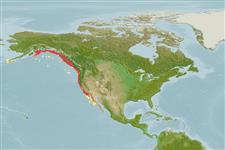Preferred temperature (Ref.
115969): 4.4 - 8.6, mean 5.9 (based on 131 cells).
Phylogenetic diversity index (Ref.
82804): PD
50 = 0.5000 [Uniqueness, from 0.5 = low to 2.0 = high].
Bayesian length-weight: a=0.01000 (0.00499 - 0.02004), b=3.09 (2.92 - 3.26), in cm Total Length, based on LWR estimates for this Genus-body shape (Ref.
93245).
Trophic level (Ref.
69278): 3.5 ±0.39 se; based on food items.
Widerstandsfähigkeit (Ref.
120179): niedrig, Verdopplung der Population dauert 4,5 - 14 Jahre. (tm=5; tmax=86; Fec=14,000).
Prior r = 0.12, 95% CL = 0.08 - 0.18, Based on 1 full stock assessment.
Fishing Vulnerability (Ref.
59153): Moderate vulnerability (36 of 100).
